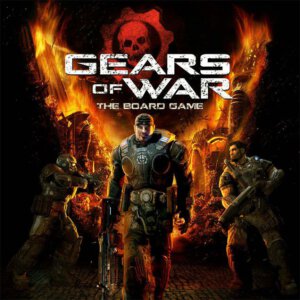
Publisher: Fantasy Flight Games
Designer: Corey Konieczka
Artist: Ben Zweifel
Year: 2011
Players: One to four players
Ages: 13+
Playing Time: 60 minutes to three hours
Category: Miniatures driven action board game
MSRP: $69.95
I’ll preface this review by pointing out I’ve never played any of the Gears of War video games. I’ve seen the games and understand the background story well enough though. Where I can’t speak of how well the video games are modeled on the table top I can let you know if Fantasy Flight’s Gears of War stands on its own as a board game and if it will engage other folks who have not played the video games.
Some people might think FFG is just looking to cash in on a hot property but this isn’t the first time they’ve designed a board game based on a computer game; Starcraft and Sid Meier’s Civilization jump immediately to mind. Yet those two previous releases are strategy titles and Gears of War is an action shooter so this new release no doubt presented some interesting gameplay decisions for the design team.
Let’s start with the components.

Set up is fairly quick and you can dive into the game within just a few minutes. The cards are divided into various decks such as weapons, missions, and map randomizers but you’ll find the main decks you’ll be using all the time are orders and Locust A.I. The Locusts are the aliens hell bent on destroying the heros.
Gears of War is a co-op game so up to four players are going to team up in an attempt to complete a mission’s objectives while surviving an onslaught of alien attacks. The players are not your average Joes and they’re going to need all of their enhanced abilities to survive.
Players each take their turn and follow a specific pattern. A player must play a card from his hand of orders. The cards normally have two or more options the player can take or he can choose to discard the order card in order to make a move or shoot action. Normally you’ll find the Order card has great options to choose from so rarely will it make sense to not take an action from the card.

Combat is simply rolling the special attack and defense dice – based on the weapon used and the defender – and hits rolled that aren’t negated by the defense dice carry over as damage. Locust effectively have hit points while players use their Order cards as health.
Once a player has finished their turn, he draws a card from the A.I deck and follows the directions on that card. A lot of these cards pertain to a specific type of Locust and most of the time it will direct those sorts of aliens to move toward and/or fire at the nearest hero. Sometimes the A.I. card will spawn more Locust. You’ll never catch a break with these A.I. cards because if the actions don’t apply to the situation, you’ll need to draw a new card until the enemy is able to do something. The enemy A.I. is one tough cookie and, once you find one or more of the heroes bleeding out, it can be very difficult to complete the mission successfully. Players are never completely out of the game though (unless you choose the character death option) so as long as the team has one man standing there’s a chance to pull off the mission.
The Locust are tough because they don’t run out of ammo, have an unlimited attack range, and thoroughly outnumber the players. Teamwork is essential and taking time to coordinate movement and attacks are especially important if you want to succeed. Using cover at every opportunity and conserving ammo for when you really need it goes a long way as well.

All in all I can’t speak to how well FFG has translated the video games to the table top but they have created a very interesting and chaotic battle game that has a lot of flavor and theme. This isn’t an easy win every time out and it takes solid play from the players to complete each scenario. Gears of War moves quickly and there’s little downtime for each non-phasing player because of the inclusion of the reaction abilities on the Order cards.
The difficulty level may be a turn off for some but those looking for a great challenge, in a co-op setting, will be very pleased with Gears of War.
[rwp-review id=”0″]


















